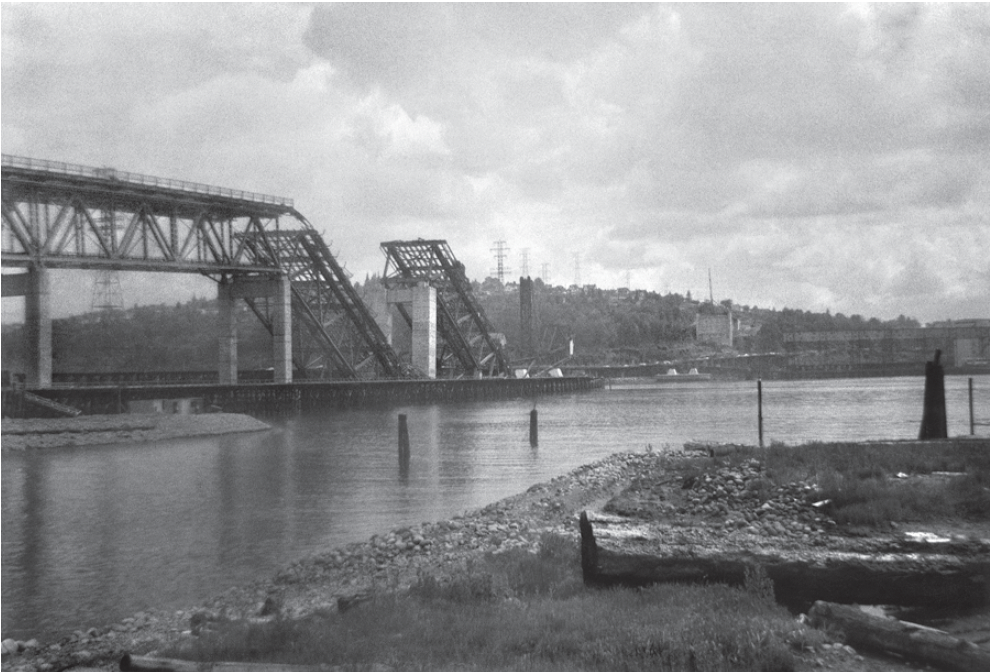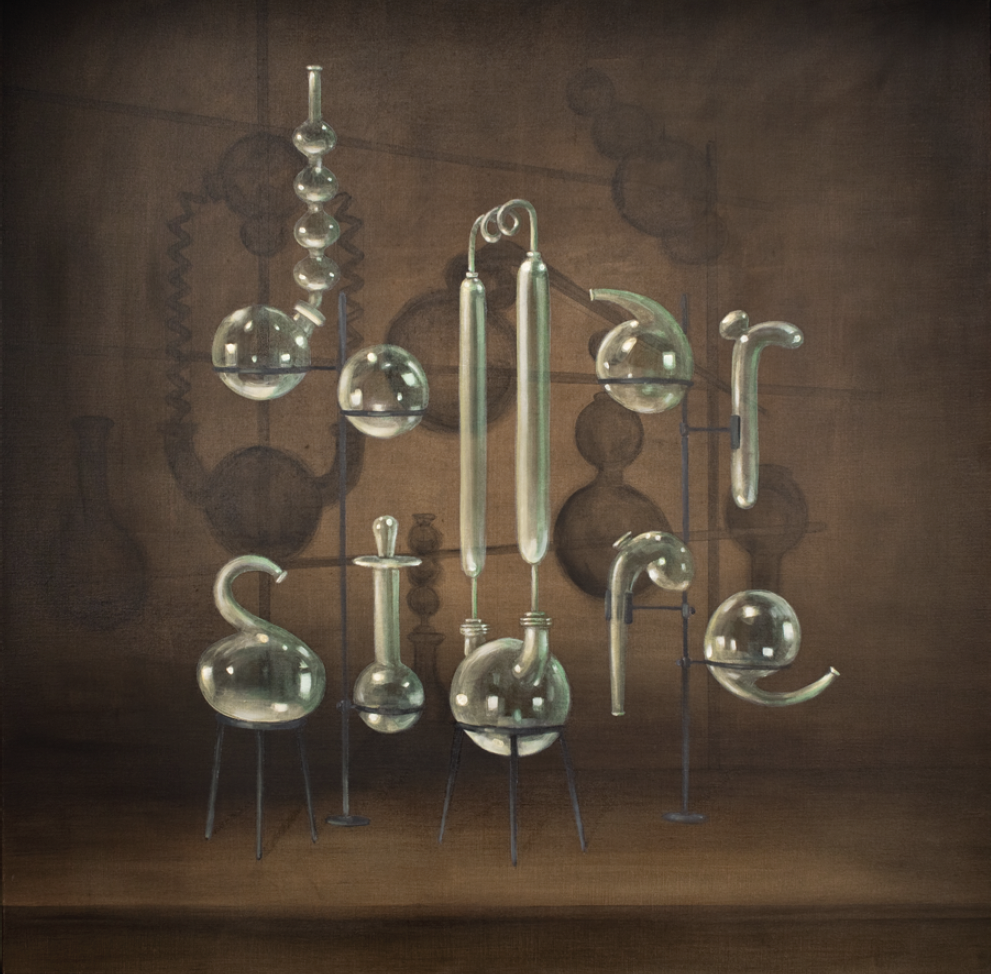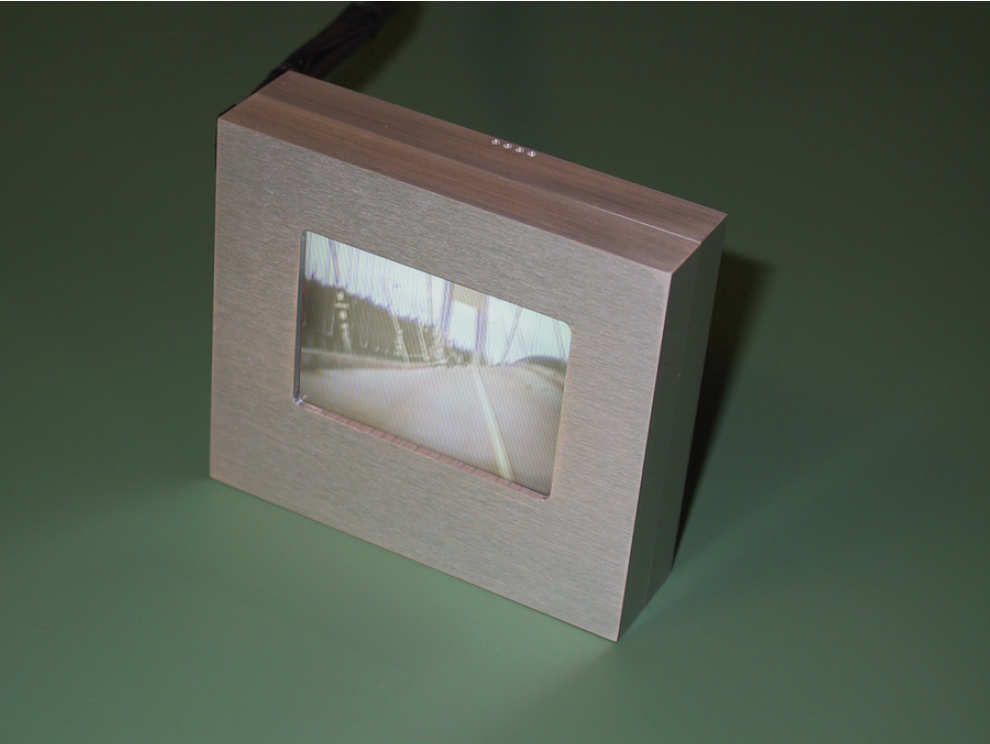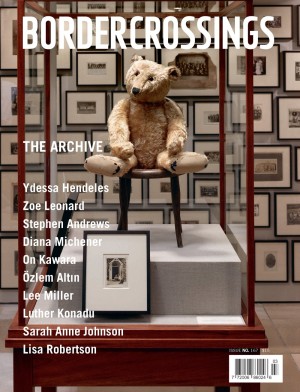“The Constant Search for a Better Way”
The title of the Simon Fraser University Gallery exhibition “The Constant Search for a Better Way”—taken from a 1962 Bell Labs advertisement— is used with dissemblance, questioning of the titular “better” being the conceit of the exhibition. Presenting multiple works by 10 Canadian artists working in different mediums, the exhibition curator and Simon Fraser University Gallery Director Bill Jeffries has sought to gather pieces that are critical of technology. Ranging from the lo-fi, as with Toronto artist Kelly Jazvac’s Transporter Beams, 2005, to the clean, tight, sculpture-video hybrid of Daniel Laskarin’s Umbilicus, 2001/2008, the art in the show comes from divergent conceptual impulses and works to varying degrees with the show’s stated theme.

Evan Lee, Stain #11, 2003, LightJet print on Fuji Crystal Archive paper, 31 ½ x 37 ½”.
Three gorgeous paintings by Neil Wedman are dotted throughout the gallery, the corners of their canvasses occluded by a delicate, deep darkness that summons up Rembrandt’s warm, layered and lacquered brownblacks— think of his 1632 work The Anatomy Lesson of Dr. Nicolaes Tulp (a lovely and apt reference for this exhibition in its presentation of 17th-century medical study at the dawning of modern scientific methodology). As Wedman lets light seep into the paintings, what is revealed, and is perhaps the source of this illumination, are delicate arrangements of glass condensers, bell jars, alembics and other test tubes. It’s easy to be caught up in the visual information contained on the paintings’ surfaces, but as your eyes pull their focus outward, these phosphorescently glowing tubules suddenly form into words. Banal phrases—“orange julius” (Orange Julius, 1998) and “dollar store” (Dollar Store, 1998), and a dingy word, “toenail” (Toenail, 1998)—are what these carefully arranged experiments have to impart to us. These satisfyingly layered paintings destabilize the enterprise of empirical, scientific methodology.

Ian Wallace, Disaster (June 17, 1958), 2004, digital print, 16 x 20”. Private collection.
One of the main elements of Kelly Jazvac’s work Transporter Beams is the ethereal green light it creates, similar in colour to that in Wedman’s works. This tripartite sculpture is a recreation of the teleportation devices from television’s Star Trek. Created at a 1:1 scale, they are made from laminated, inkjet-printed, letter-size bond paper, Scotch taped together. Hanging from the ceiling, they are each located on one of the gallery’s lights, the beams’ bases hovering a liminal distance from the gallery’s floor, and held in place with deliberately awkward swaths of packing tape. Co-opting the gallery’s illumination system, this sculpture becomes both an elegiac lamentation of the current impossibility of such a device and a low-end engagement with the activities that engage so many behind closed bedroom doors and in secluded basements, while also operating as singularly beautiful and really funny neo-Minimalist sculptural work. This sculpture is part of a larger series of works wherein the artist created full-scale sections of Star Trek’s Starship Enterprise spaceship, exploding the hobbyist’s usually diminished scale up to life-size. Here the Beams appear alone, and an engaging tension emerges as the work literally comes to life only through the mechanism of the gallery space.

Neil Wedman, Dollar Store, 1998, oil on linen, 39 ½ x 39 ¼”. Private collection.
Other works don’t fare as well in the exhibition, with some good pieces being done disservice through placement and scale relations. Jon Sasaki’s photograph Untitled (Stanchion), 2007, is a witty and poignant work typical of his output; in it, a stanchion meant to protect a large Modernist painting hung in an institutional setting is instead toppled and leaning against its ward. This work is awkwardly squeezed onto the side of a gallery pilaster, while Sasaki’s video Ladder Climb, 2006, is oddly displayed on a low-sitting CRT monitor placed on what seems to be a gallery credenza. Sasaki’s wry melancholy and everyman malaise fits perfectly into Jeffries’s curatorial enquiry, and as such, it is unfortunate that his work is so disadvantageously presented.

Daniel Laskarin, Umbilicus, 2001/2008, “Bridge green” painted steel table, cut in half at an angle, propped against the wall, aluminium monitor housing, video loop, cables.
Assembled closely in the intimate space of the SFU gallery, the artworks in the exhibition feel as if they are floating inside a tiny capsule within the awesome mother ship that is Arthur Erickson’s 1963 Simon Fraser University campus. Given the exhibition’s curatorial directive to question the modernist impulse towards the new and the improved, it’s easy to extend this line of thought to the dominant architectural space that encapsulates the show. This Brutalist structure, often mentioned colloquially in conjunction with SFU’s student suicide rate, is actually a lovely, sprawling structure that encloses tiered grassy expanses, dotted with reflecting pools and nestled into a Burnaby mountainside. A popular filming location for shows such as Battlestar Galactica (where it has been cast as the ruins of a museum of interstellar colonialism) and The X-Files (for which it has played FBI headquarters), this particular Modernist undertaking would seem to be able to function as a tabula rasa for whatever one would like to put on it. Similarly, it is impossible to assign singular readings for many of the works included in this exhibition, even while Jeffries’s curatorial directive presents an opportunity to consider them in one particular light. ■
“The Constant Search for a Better Way,” curated by Bill Jeffries, was exhibited at the Simon Fraser University Art Gallery from June 20 to August 1, 2008.
Katie Bethune-Leamen is a visual artist and writer based in Toronto.

